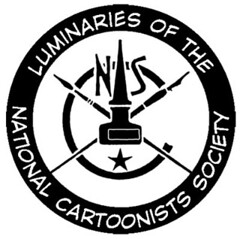 The Reubens, the annual awards ceremony of the National Cartoonists Society (of which I am a proud member) is now under way. I'm actually putting together this post in my hotel room at the event! As in previous years, I'm using this week as an opportunity to showcase some of the Luminaries of the NCS. Today, Leonard Starr.
The Reubens, the annual awards ceremony of the National Cartoonists Society (of which I am a proud member) is now under way. I'm actually putting together this post in my hotel room at the event! As in previous years, I'm using this week as an opportunity to showcase some of the Luminaries of the NCS. Today, Leonard Starr.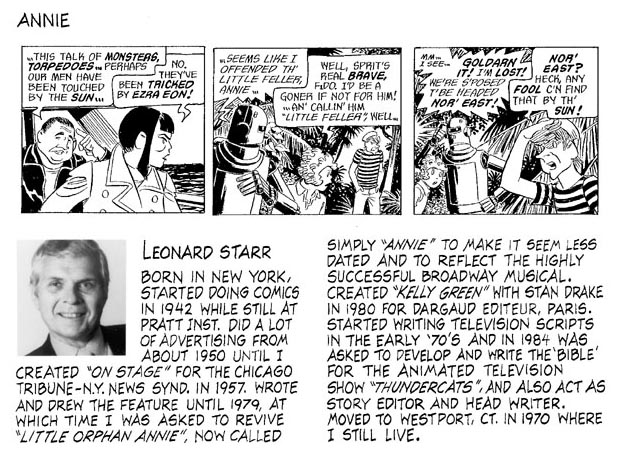
My friend Tom Sawyer (whose career was the subject of a week of posts here on TI in 2008) has graciously agreed to share another excerpt from his memoirs. Tom picks up the story where we left off yesterday; in those first few days of drawing backgrounds in the studio of the artist Tex Blaisdell had nicknamed ‘Glamorous-and-Unpredictable.’
Excerpted from Thomas B. Sawyer's memoirs:
"Leonard Starr appeared several days later, in town from his home in Centerport, on Long Island’s North Shore. His presence didn’t disappoint. Handsome, tall, blonde, self-assured, witty and, true to Tex’s billing, striking in a star-quality way.

We hit it off immediately, beginning what would become the single closest friendship I would ever have – the kind where, even after weeks or months without contact, our wide-ranging conversations would resume as if there had been no interruption, endlessly stimulating as always. Books, art, movies, theater – and especially, once he’d educated me about it, music."
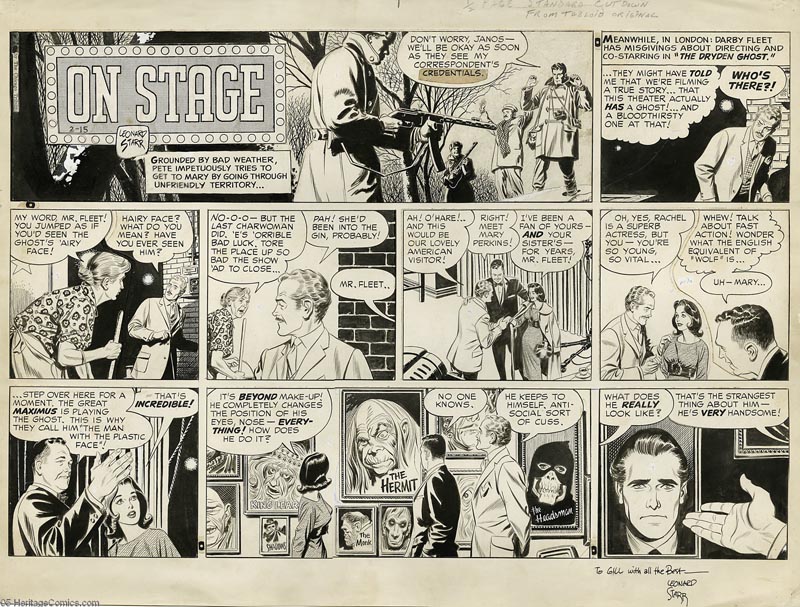
"And among the best of all, for me, was the fact that he liked my work, quickly ‘promoting’ me from merely doing backgrounds to handling ‘breakdowns’ as well. Another new piece of terminology, this consisted of taking the scripts he was given, and laying out the pages, deciding on panel-size and shape, rough-penciling the figures, arranging and loosely lettering dialogue balloons so that the lettering-man had sufficient space. Storytelling, actually, and in a cinematic way."

"Through Leonard, John [Augustin] and Tex, I began to meet and socialize with other artists, some who’d drop by the studio, several of whom would become close friends, meaningful players in my life for years to come, Stan Drake, Warren King, John Prentice and Howard Post, to name a few."
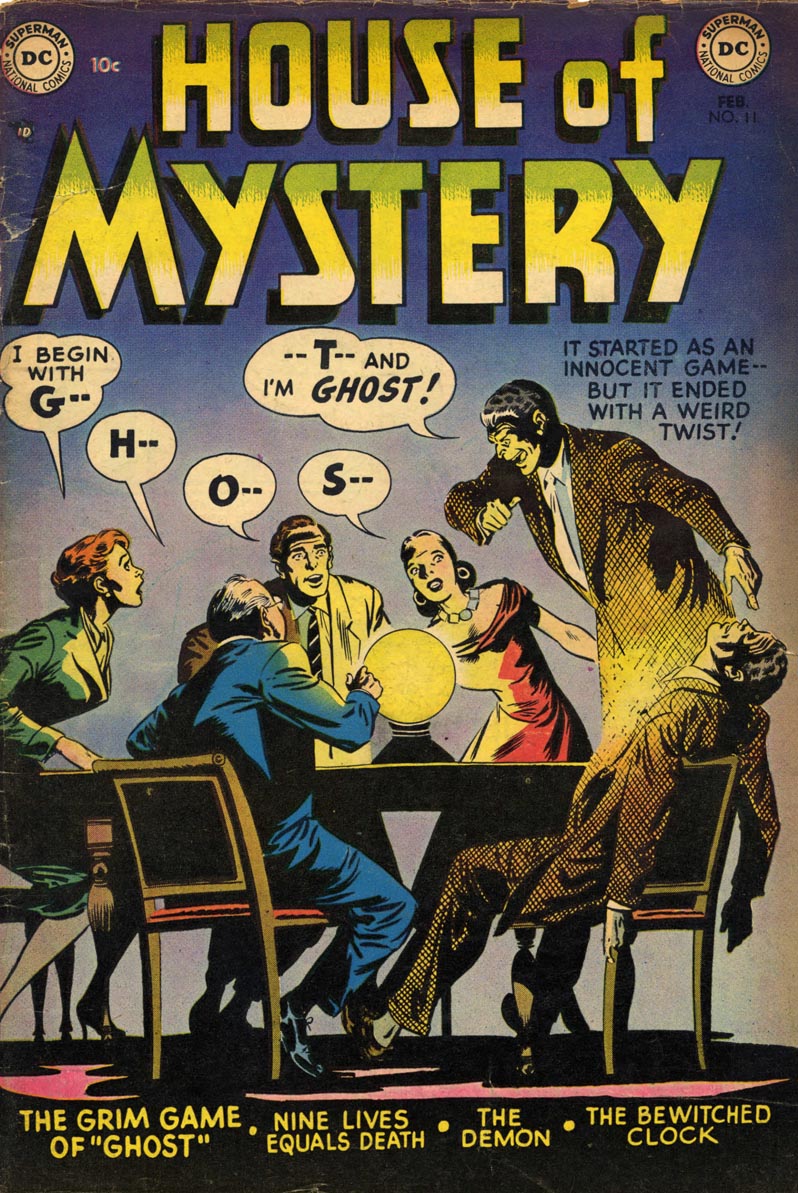
Leonard Starr has come up in the course of discussion in other posts on Today's Inspiration. On one occasion, while discussing illustrator Frank Reilly's art school, David Apatoff provided these recollections from Starr, who had attended the Reilly school:
"Reilly was the best teacher I ever saw-- the only one who was really worthy of the title, "teacher." My teachers at Pratt were all tired re-treads, who were interested in 2 dimensional design but couldn't teach you how to draw. They would walk around the room and remind you that the human hand has 5 fingers. I learned far more from the Famous Artists School training materials."

"Then one day when I was 27 I was talking with Dean Cornwell at the bar at the Society of Illustrators. I was already doing well as a professional artist but I still felt I had real gaps in my learning. Dean told me that he was "impressed with the work that Frank Reilly's kids are doing." So I went to Reilly and he took me on as a student."

"Reilly taught that drawing was a matter of "relationships"-- from the neck to the hip bone, from the tip of the shoulder to the groin, he showed us how everything combined to make the figure come alive. Kids always start out making the figure lean to one side or the other, but Reilly showed us how to nail that figure down: "at least one of those legs must be supporting the weight of that body." He was just remarkable. I never left a class without learning something new. I wish he had been my teacher starting in high school, then I would really have been able to draw. He was better than George Bridgman (who Reilly dismissed as "an anatomist.") Unlike Bridgman, Reilly taught you in a way that made the anatomy naturally go where it was supposed to go."
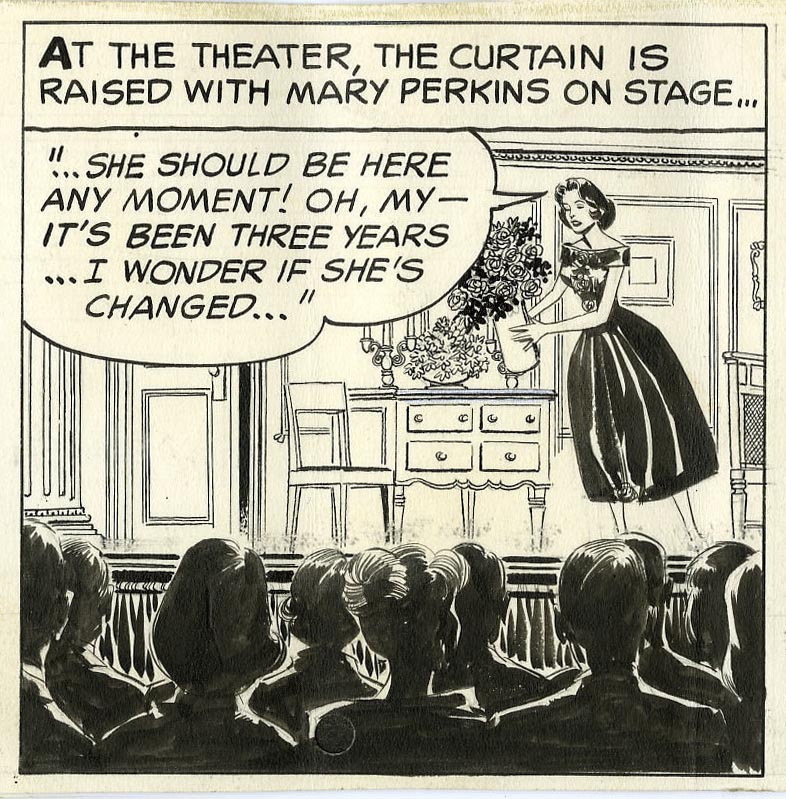
... and for a post on NCS member John Prentice, David provided the following quotes from Leonard Starr, which shed light on how his "On Stage" strip came into being:
"Johnny and I shared an apartment in Manhattan-- it was a dreadful little place-- but we were living "la vie Boheme," making a living as artists (although not a very good one. Whoever received the last check paid for the groceries). We worked for Johnstone and Cushing and other places, but I was shopping around some comic strips to syndicates (including On Stage). Then one day, we got word that Alex Raymond had been killed in a car crash. I received a call from Sylvan Byck, the cartoon editor for King Features. He told me that Raymond had only worked two days ahead, and the syndicate was in a panic."

"Could I come right over and take up Rip Kirby where Raymond had left off? I thought about it... Rip Kirby was a sure thing, and it was very tempting, but I decided to take a chance and try my luck with my own strip a while longer."

"So I told Sylvan, "You don't want me, but the very best guy in the world for the job is sitting right next to me." Sylvan responded, "send him right over!" And that's how Sylvan met Johnny and Johnny got the Rip Kirby strip."

"It turned out, that same day, the head of the Chicago Tribune Syndicate was on a train reading a newspaper, saw that Raymond had died, and got off the train at the next stop to send me a telegram confirming that I would be doing On Stage for his syndicate. He figured that King Features would be looking for a replacement for Raymond. So Johnny and I each got our strips at the same time, and took off from there."

* Many thanks to Tom Sawyer for sharing this wonderful excerpt from his memoirs with us.
His portion of the text in today's post is Copyright © 2010 by Tom Sawyer Productions, Inc.
* Thanks to David Apatoff for sharing the quotes from Leonard Starr that appear in today's post.
* I'd also like to thank Alan Light, for allowing me to use his photo of Leonard Starr at the conclusion of today's post.
* Thanks also to Heritage Auctions for allowing me to use all the artwork scans from their archives to illustrate this post.
Those are just some really amazing stories about some of my favorite artists. Thanks so much.
ReplyDeleteLeonard Starr is without a doubt my most enduring influence and love of the newspaper strips artists that are rapidly fading into the past.
ReplyDeleteI love his work. The brush work. The detail with such simplicity.
He's one of the best of all time.
The reprints of ON STAGE being put out right now are fantastic.
Frank Reilly is one of those artist/teachers that you never hear a bad word about.Held in similar regard as Howard Pyle and an absolute master of his craft.
ReplyDeleteBut also very demanding of his students.No slacking.He was the real deal.
We will probably never see his like again.
As to these memoirs of Mr Sawyer,are they to be published? available online? They are certainly very interesting and informative.
A great week Leif.
I agree with Tom. Leonard Starr is absolutely brilliant. He did superb work of enduring value.
ReplyDeleteWhat a remarkable post!
ReplyDeleteThe more I learn, I can see the clear connections from one artist to the next, regardless of style, trends and commerce.
It was great and surprising to read about Leonard Starr getting advice from Dean Cornwell!
I recently saw the LA County Museum's show "American Stories: Paintings of Everyday Life, 1765–1915". I was struck that at the end of the show they had John Sloan and William Glackens, but could have easily just continued the show by including Norman Rockwell, F.R Gruger, Wallace Morgan, and so many other great artists who happened to come along when the best employment opportunities were in print. I would get more out of going to a museum to see works by any of those three artists than a Thomas Eakins painting-- great as he is (just my humble opinion).
Obviously Rockwell had soaked up much of the American story type painting style -- you could almost feel his absence in the show. Gruger was a co-worker and close friend of Glackens, I think, and Sloan started with them as a newspaper sketch artist, if I'm not mistaken.
Thanks so much for doing this Leif.
Hopefully in the future, museums will see the type of work that you are doing and knock down these ridiculous barriers, so that we can go see work like Leonard Starr, etc alongside Norman Rockwell and Robert Crumb, who are now allowed in great museums. Didn't Rockwell greatly admire and learn from Velasquez? Didn't Velasquez also devote his life to being strictly a commercial artist??
Oops, I think I posted my comment with another Google account I created for my daughters birth announcement!
ReplyDeleteHere is my usual online profile, I hope.
Damn you Google...